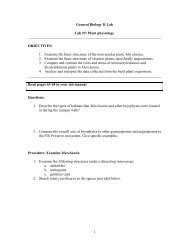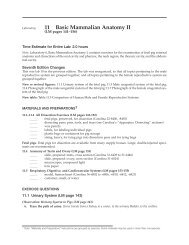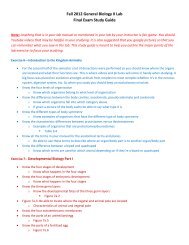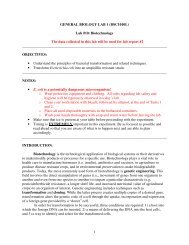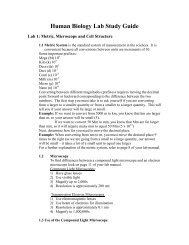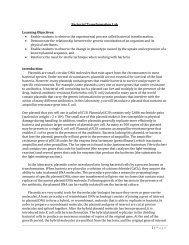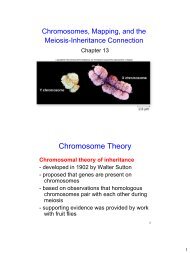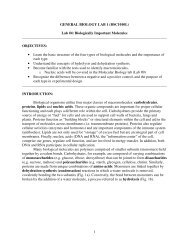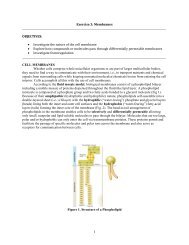GENERAL BIOLOGY LAB 1 (BSC1010L)
GENERAL BIOLOGY LAB 1 (BSC1010L)
GENERAL BIOLOGY LAB 1 (BSC1010L)
You also want an ePaper? Increase the reach of your titles
YUMPU automatically turns print PDFs into web optimized ePapers that Google loves.
The active site determines the specificity of every enzyme. Specificity can result<br />
from the charge, shape, and hydrophobic/hydrophilic characteristics of the enzyme and<br />
substrate molecules. Only reactants that match the geometric shape of the active site can<br />
bind to the enzyme. This specificity is also known as the “lock and key model” where<br />
the substrate (the key) fits into the active site (the lock) of an enzyme. However, as<br />
mentioned previously, the interaction between a substrate and the enzyme’s active site is<br />
not static. When a substrate binds to the enzyme, the active site is reshaped by the<br />
interactions of the enzyme’s amino acid side chains with the substrate molecule. This<br />
protein remodeling enhances the overall binding of the reactant to the active site,<br />
increasing catalytic action. The ability of enzymes to mould their shape to enhance the fit<br />
of substrate molecules is known as the “induced fit model.”<br />
There are thousands of different enzyme types, each with a specific set of<br />
conditions at which it works best, i.e., its optimal conditions. An enzyme’s optimal<br />
conditions often reflect the environment(s) of the organism(s) in which it is found. For<br />
instance, the optimum temperature for enzymes present in Thermophilus aquaticus, an<br />
extremophilic bacterium that inhabits hot springs, is about 70ºC. In contrast, peroxidase,<br />
an enzyme present at high concentrations in turnips, horseradish roots and potatoes,<br />
works best at temperatures around 45ºC.<br />
Enzymatic activity is affected by multiple factors, including pH, substrate<br />
concentration, salt concentration, as well as the presence of inhibitors, activators and<br />
cofactors. In this lab, you will examine the effect of temperature on enzymatic reactions.<br />
Temperature affects the rate at which substrate and enzyme molecules collide. At<br />
temperatures greater than the optimal, the active site denatures (i.e. changes shape),<br />
decreasing or preventing substrate binding. Consequently, product formation is either<br />
reduced or completely arrested. At the other end of the spectrum, low temperatures<br />
decrease the movement of molecules, resulting in less contact between enzymes and<br />
substrates, which slows down the frequency and rate of reaction, and ultimately<br />
diminishes product formation. Although the effect of temperatures outside of the optimal<br />
range on substrate catalysis is the same, the mechanism through which enzyme activity is<br />
reduced, differs.<br />
The objective of the current lab is two-fold; (1) to examine how variations in<br />
temperature affect the activity of the enzyme amylase and (2) to determine the optimal<br />
temperature for amylase from two different sources (fungal and human).<br />
Amylase catabolizes starch polymers (a storage polysaccharide) into smaller<br />
subunits (monomers = saccharides) including maltriose, maltose and short<br />
oligosaccharides comprised of 2-20 monosaccharide units (Fig. 3). Most organisms use<br />
these saccharides as a food source and to store energy (Fig. 4). Both starch and amylase<br />
are important commercially in the production of syrups and other food products, as well<br />
as for fermentation and brewing processes.<br />
3



